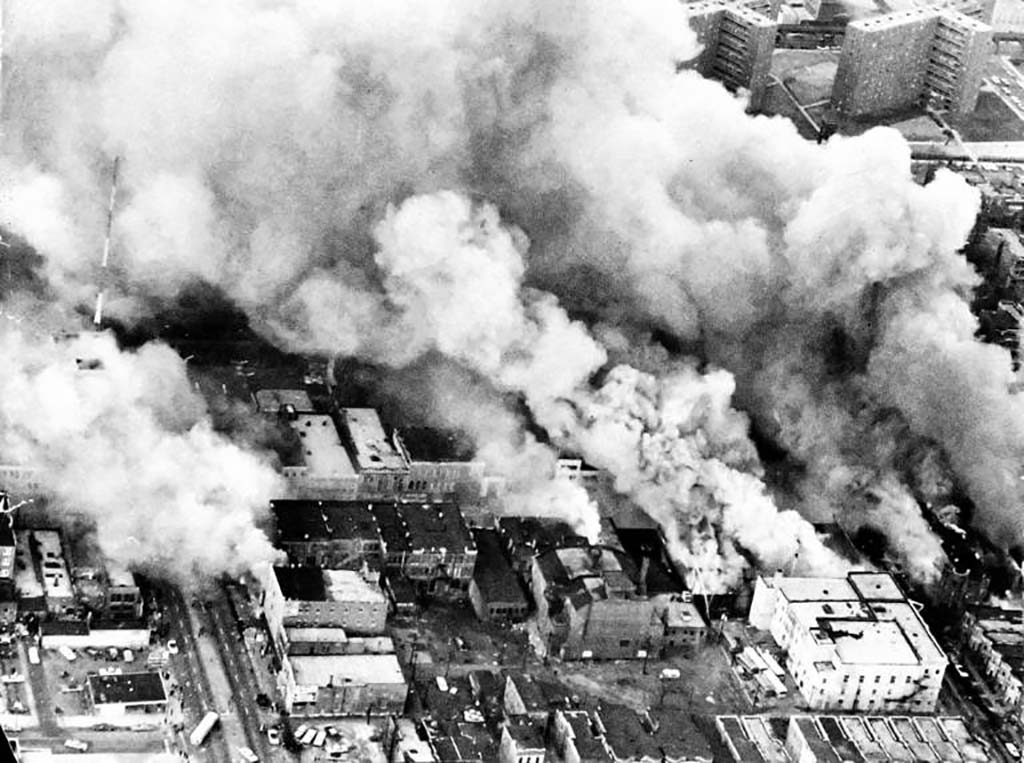The King Assassination Riots were a series of more than 100 cases of civil unrest that occurred in the wake of the death of Dr. Martin Luther King Jr. This turmoil was apparent throughout the nation as racial tensions rose to a volatile level. Different degrees of unrest were seen depending on the city in which it took place.
On April 4, 1968, civil rights leader Martin Luther King Jr. was assassinated in Memphis, Tennessee. The news of his assassination led to an outpouring of different emotions from blacks around the United States. The assassination was also a catalyst for civil unrest, and many took to the streets to express their grief and anger in the form of marches and protests. Not all of these demonstrations remained peaceful and, in some instances, turned violent. Some of the most notable riots occurred in Baltimore (Maryland), Chicago (Illinois), Louisville (Kentucky), New York City (New York), and Washington, D.C.
The unrest in Baltimore came into motion on Friday, the day after King’s assassination, but tensions had been building beforehand due to frustrations in the Black community. Thousands of National Guard troops, 500 Maryland police, and numerous federal troops were brought to the city in response to the events. The riot resulted in more than 4,000 arrests, and over a thousand businesses had been burned or looted. $13.5 million in damage was sustained in the city.
In Chicago, riots also began on Friday, April 5, and occurred primarily on the city’s West Side. The scene in Chicago was characterized by looting, arson, and violence. Three thousand Illinois National Guard troops were ordered into the city to help police and Cook County Sheriff’s Deputies keep the peace. The unrest in Chicago led to eleven deaths and over a hundred destroyed buildings.
The events in Louisville took place in May. They were instigated in part by King’s assassination but also by the fact that the police department reinstated a white officer involved in the beating of a Black man after a brief investigation. Numerous troops of the Kentucky National Guard tried to quell the violence taking place in Louisville. Over 400 arrests were made, and $200,000 in damages resulted from what had happened.
Although damage, looting, and violence did occur in New York City, they were primarily mitigated in part by the actions of the city’s mayor, John Lindsay. Mayor Lindsay went into Harlem, interacted with its residents, and calmed the people by saying he was sorry about what happened to Dr. King.
In Washington, D.C., the riots began on the same day Dr. King was assassinated. The unrest in the nation’s capital led to over 1,000 buildings being burned and $27 million in damages. Numerous National Guard troops and Marines were called into D.C. to help maintain order.
President Lyndon B. Johnson condemned the assassination of Dr. King. He initiated a series of legislative acts that many in the White House believed would improve conditions for African Americans in the inner cities. The Fair Housing Act passed by Congress on April 11, 1968, was one such measure. Congress, however, rejected the rest of Johnson’s proposals, believing the president did not do enough to suppress the urban violence.
The King assassination riots added to the numerous riots that occurred in Los Angeles, California, in the 1960s, such as the Watts Riots in 1965. King’s death was superimposed upon other racial issues already facing many cities, and to many Blacks, it seemed the rejection of his non-violent approach to racial reform. However, the damage in the wake of King’s death also damaged many city’s economies. As a result, thousands of jobs were lost, crime increased, property values decreased, and most Black communities were even more isolated from the rest of their cities than before the violence.

